World Dream Bank
home -
add a dream -
newest -
art gallery -
sampler -
dreams by
title,
subject,
author,
date,
places,
names
Abyssia: Geology and Geography
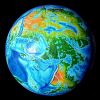
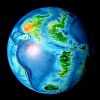
by Chris Wayan, 2011
UNDER CONSTRUCTION! These are just notes to myself, really.
Abyssia home - down to
map -
building Abyssia -
geology & geography -
critters & cultures -
the clash of names -
more worlds? Planetocopia!
Geographically, Abyssia resembles ancient Earth. Scientifically literate readers are already muttering "Which ancient Earth?" The steamy, flooded Carboniferous? Snowball Earth, or its baby sister the Pleistocene? Pangea's vast deserts and extreme monsoons?
The answer: ignore climate a moment. Ancient Earth's surface also consistently differed geographically and chemically from modern Earth. The two biggest changes have served life well, and they're direct results of life (which doesn't prove the Gaia hypothesis, but certainly can't hurt):
- Free oxygen produced by plant life made high-energy, active animal life possible. Over all the oxygen percentage has climbed, but not smoothly; in lush times Earth has had more free oxygen than now! Abyssia, with more biomass than Earth, is oxygen-rich--though Earth in a few rich eras had even more.
- Earth's continents grow and shrink as the sea ebbs and rises, but its continental platforms have grown steadily over the eons. Lighter sandstone and limestone, largely created by life (especially reef organisms) accrete into platforms guaranteeing extensive landmasses and fertile shallows--coral and rocky reefs, kelp forests, lagoons and estuaries. About 27% of the surface is land, and 6% more is shallow sea, much of it extremely fertile, since minerals are more available here. Now, life has been just as busy on Abyssia, but the geological accretion of such lighter rocks into large continents has lagged because the land is so small and scattered to start with. On Abyssia, there is no polar ice (except sea ice, which doesn't affect sea levels), and icecaps are unlikely for at least 50 million years. There simply isn't a platform for it to build up on; Abyssia's tectonic plates may eventually carry one of the southern continents (I'd bet on western Weddellia) close enough to the pole to ice over, but it won't happen tomorrow. Even then, it's small; no Antarctica.
The result? Abyssia has stable, high sea levels and a low ratio of land to shallow sea: 12% land, 13% shallows. As these numbers show, the land suffers a double blow: Abyssia's continental platforms (flooded or not) are smaller in absolute terms, too--about 1/4, where Earth has 1/3.
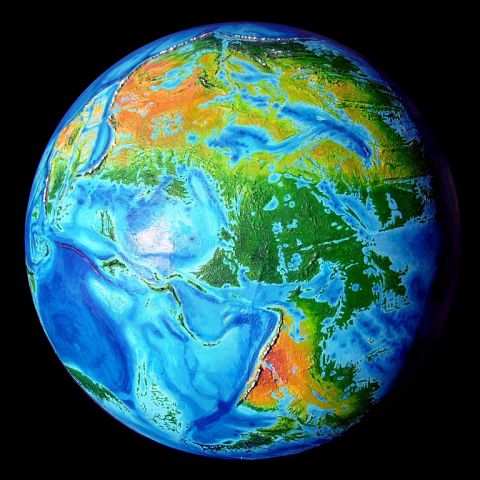
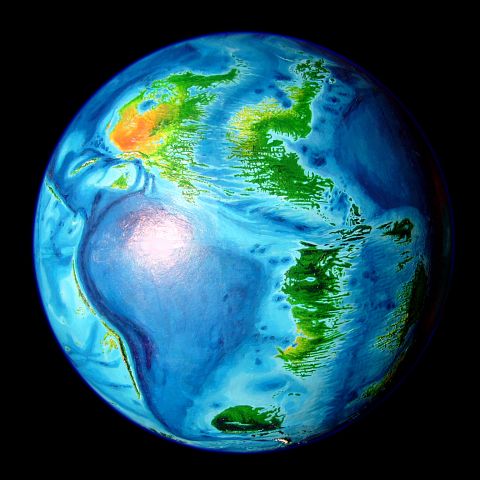
So "Which ancient Earth" has an unambiguous answer: a hot, wet, flooded, coral-rich era. Abyssia's climate isn't Carboniferous-hot; but its geography is maritime. Not much land, though what there is runs toward rainy and fertile. Few unbroken continental interiors, mild temperature fluctuations, few deserts (hence less dust than Earth; and dust is an important long-term fertilizer, evening out topsoil imbalances and feeding mineral-starved life in the open sea). Sea life concentrates in the shallows. Lands are small, broken--but green. To mangle Gertrude Stein, "There is no inland inland."
ICE AGES?
I said Abyssian climate doesn't fluctuate as much. But is that always true?
Well, yes, in the short term--as in, the next 50-100 million years. Until continental drift can slip a big landmass right atop a pole so it ices over, temperatures and sea levels won't drop much. No land lies close to either pole now. Even in the deeper future, it won't happen too often. Abyssia has so few continents--just a flotilla of modest islands totalling just half of Earth's land area, one-eighth of its surface. Even when something does ice over it's likely to be an island--a Greenland, not a full continent. One or two million square/cubic km of ice does lower temperatures and sea levels, but it's not a true Ice Age. Right now, in our Interglacial, we have ten times that! The Southern Ring, that arc of large islands/small continents around the south pole now, just isn't big enough to create more than a Terran interglacial even if a large part of it straddled the pole. By its shape, not all the Ring can be polar at once.
The only conceivable Abyssian ice age, and it'd still be a fairly mild one compared to Earth's (at peak, we had at least FIFTY millon square km under ice!), would be if Pacifica itself swings far north. Nothing else is big enough to affect world climate that much. And even if Pacifica packed up and started trekking north tomorrow, it's low-latitude now. It has a long, long way to go.
DEAD AS A DINO
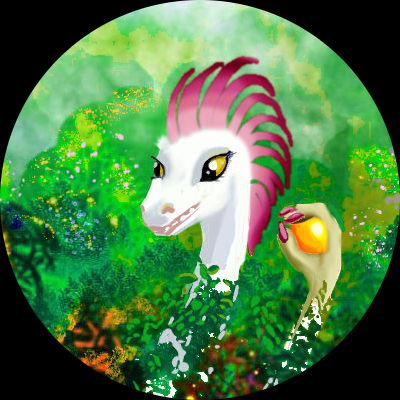
That's Abyssia's future. What of its past? Since Abyssia is Earth, it's in the same orbit. The same huge rock hit Abyssia 66 million years ago and caused a mass extinction. Without a lot of digging and reconstruction, we can't be certain Abyssian dinosaurs were centauroid; we can be certain they died, just as they did on Earth. Same impact, same spot, same catastrophe, right?
Not quite. On Earth, most creatures died not in the blast, fires or tsunamis but in the years-long 'impact winter' or the heatwave after--the pulverized limestone of the Chicxulub site caused a spike in CO2 and temperatures. Not a single but a double whammy. Only small mammals and birds made it through cold and heat--presumably by eating seeds, the longest-lasting food. In the flying dinos who made it, that favored beaked species. Now we call them birds. They couldn't reverse-engineer their beaks to jaws with lips and teeth even if these'd be useful for modern non-seed diets. Evolution has no "undo" button!
Chicxulub didn't just kill off most dinos, it permanently marked the survivors.
But was Abyssia's extinction as severe? On Abyssia Chicxulub isn't coastal, but deep sea. The impact raised way less dust blocking sunlight. Further, it wasn't limestone (a legacy of eons of sunny shallows) but abyssal basalt, so it didn't raise CO2 levels later. Milder blast-winter, and no heatwave after. Yes, a worldwide tsunami and firestorms and blast waves doomed most land animals, but a wider variety of small creatures, especially fliers, might have survived these briefer scourges.
There's a rival theory that what really killed off the dinosaurs were the huge eruptions of the Deccan Traps--climate swings, CO2, sulfur (acid rain!) ash, lead, and mercury. Suppose this theory is correct; then Abyssia still comes out ahead. Here, the Deccan is miles deep; just another abyssal basalt plain. Deep-sea eruptions just don't do as much damage.
Modern Abyssian birds could thus have teeth and other dinosaurian traits lost on Earth. Facial muscles, lips, cheek pouches, external ears? Who knows? I had fun drawing wildly diverse Abyssia's avian peoples, but I didn't do it only for fun; logically, they really should be more varied than our birds.
Abyssia isn't a full-on Dino Earth where the impact never happened, saurians survived, and mammals never dominated. And yet... you'll notice in most of the regional tours that avians are more prominent, more mammals' equals. Because more dinos did survive. Directly due to the relative sterility of the abyssal floor, compared to those rich, deadly reefs at our Chicxulub; or, if you favor the volcanoes of Deccan, a lot of harmless pillow lava miles deep compared to a million years of ash and acid rain.
The abyss saved Abyssia. Or at least defined it.
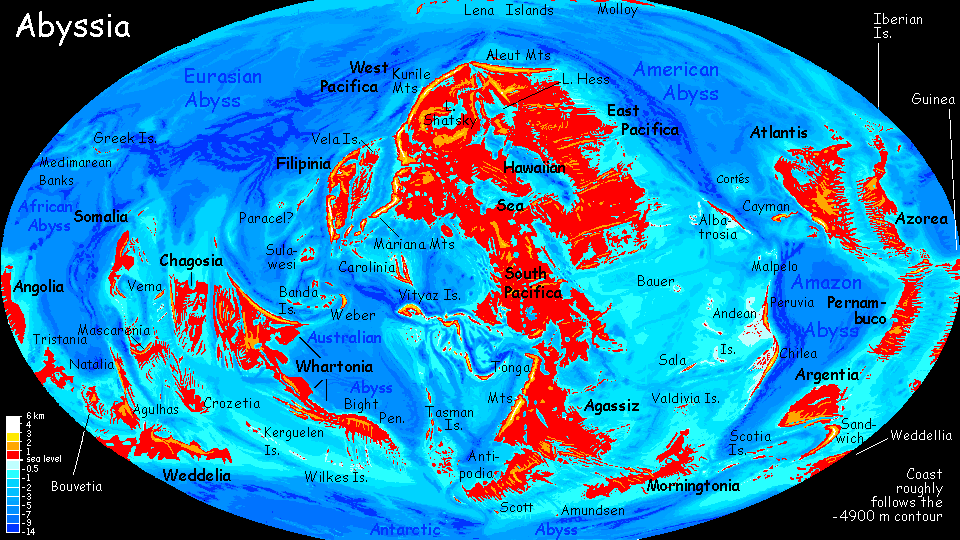 TOURS: this route snakes around Abyssia's major lands -
Lena Is. (brr!) -
Greek Is. -
Atlantis -
Azorea -
Cayman and Albatrosia -
Andean Is. -
Scotia Is. -
Morningtonia -
Agassiz -
South Pacifica -
East Pacifica -
Hawaiian Sea -
Pacifica Desert -
Filipinia -
Banda Is. -
Vityaz Archipelago -
Tasman Is. -
The Bight -
Whartonia -
Chagosia -
Somalia -
Mascarenia and Crozetia -
Weddellia -
Argentia -
Pernambuco -
Angolia -
Tristania -
Agulhas group
TOURS: this route snakes around Abyssia's major lands -
Lena Is. (brr!) -
Greek Is. -
Atlantis -
Azorea -
Cayman and Albatrosia -
Andean Is. -
Scotia Is. -
Morningtonia -
Agassiz -
South Pacifica -
East Pacifica -
Hawaiian Sea -
Pacifica Desert -
Filipinia -
Banda Is. -
Vityaz Archipelago -
Tasman Is. -
The Bight -
Whartonia -
Chagosia -
Somalia -
Mascarenia and Crozetia -
Weddellia -
Argentia -
Pernambuco -
Angolia -
Tristania -
Agulhas group
Abyssia's homepage - map - peoples - regional tours - names
LISTS AND LINKS: More worlds? Planetocopia! - dreams of other worlds - ecology - climate change - evolution - natural disasters - terraforming - sculptures and 3D art -
World Dream Bank homepage - Art gallery - New stuff - Introductory sampler, best dreams, best art - On dreamwork - Books
Indexes: Subject - Author - Date - Names - Places - Art media/styles
Titles: A - B - C - D - E - F - G - H - IJ - KL - M - NO - PQ - R - Sa-Sk - Sl-Sz - T - UV - WXYZ
Email: wdreamb@yahoo.com - Catalog of art, books, CDs - Behind the Curtain: FAQs, bio, site map - Kindred sites